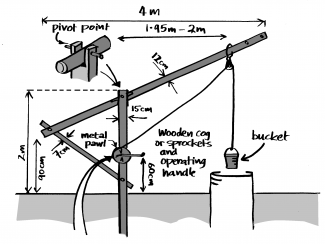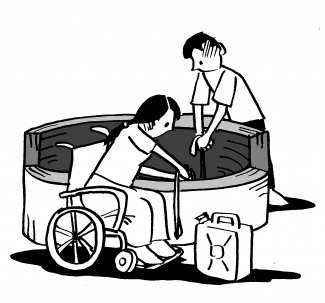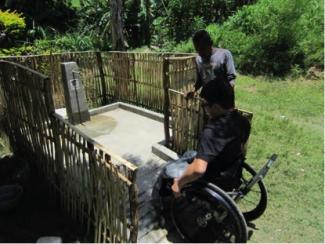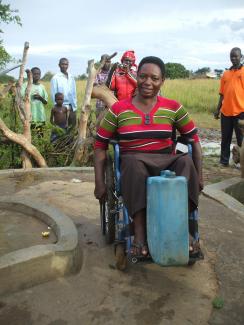Well
Different simple arrangements can be made when constructing wells, or adapting existing ones, which will make it easier for everyone to safely collect water, including for persons with disabilities.
In case of lifting devices, using a ratchet and pawl will allow a winding and locking mechanism for the rope (as shown in the drawing below).

Using a simple pulley arrangement (see picture below) over a shallow well offers different advantages, such as:
- The person pulls down on the rope to get the water, which is easier than pulling upwards;
- The person can operate from a standing or sitting position as there is no need to lean over the edge of the well to lift the water, a person sitting beside the well can operate it.

In case of water tables less then 7m below the surface, it could be worth to install a treadle pump designed to be used using the feet. The user pushes down alternatively on the ends of two lengths of wood which are pivoted around a metal bar. The wooden beams are connected to a simple twin cylinder suction pump that draws water through a pipe from a nearby shallow well. It can be operated using hands or feet and it is easy to used by people with a range of impairments.

If you are dealing with an open well, without lifting mechanism, several arrangements on the raised wall will facilitate access to persons with disabilities, elderly and young persons:
- Plan for a wall of different heights: the height of the wall should be between an adult's hip and waist (approximately 0.80m high). It should be strong enough to support the weight of a person leaning on it while getting the water from the well. For a wheelchair user or a person sitting next to the wall, the wall should not be above the height of their waist or armrest (approximately 0.50m high).
- A flat cover of the wall (wood or concrete) with an access hatch (handle) will provide additional surface to lean on and to rest the water container. In addition, it will reduce the risk of water contamination and the risk of accidents.

Apron access is important for any type of well, and particularly where you have a handpump. Making the apron non-slippery, wide enough for a wheelchair user, and with guidance for people with visual impairments makes the well more usable for everyone.
Find below some examples of well aprons made accessible depending on type terrain and context.
Once again, getting the participation of man and women with disabilities will ensure a better quality of the design.

